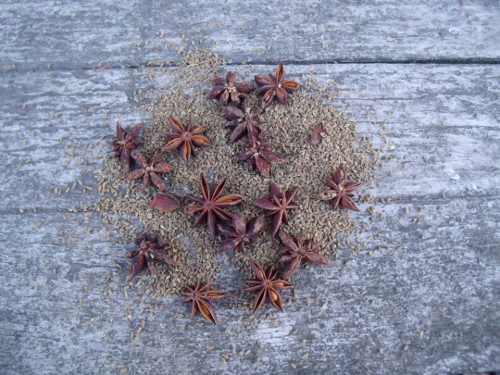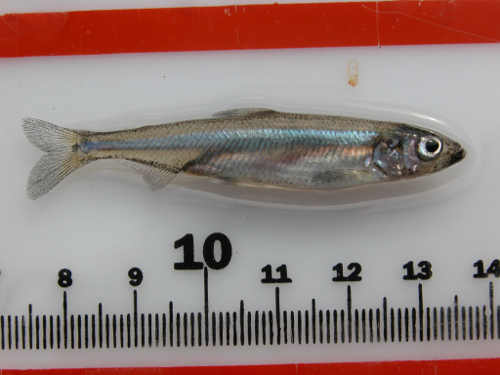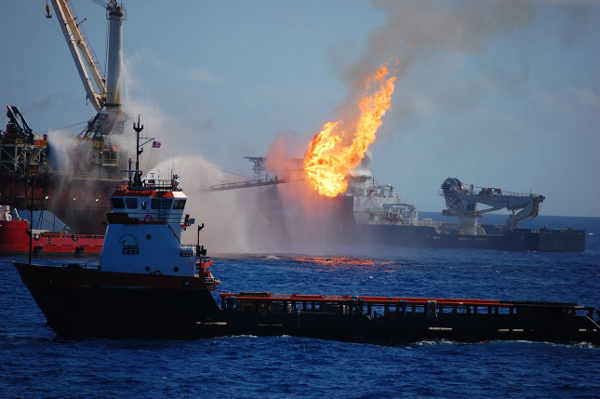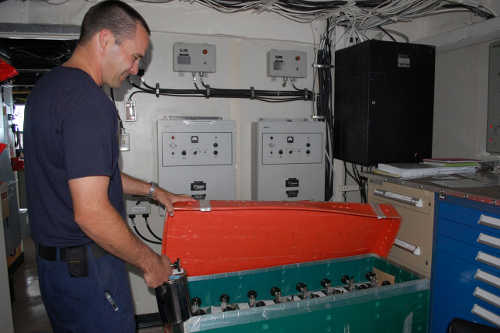
Caribou in late winter, Denali National Park, Alaska. Photo courtesy of US Geological Survey.
Caribou, North America’s wild reindeer, have lives apart from their famous role on Christmas Eve.
USGS caribou (and large mammal) expert Layne Adams, Ph.D., has studied caribou in Alaska for 30 years, helping land managers understand the best way to manage this important species. He has continuously studied caribou population dynamics and predator-caribou relationships in Denali National Park since 1986.
He offered the following details about the lives of caribou for those other 364 days of the year.
Why are reindeer sometimes called caribou and caribou sometimes called reindeer?
“Reindeer” and “caribou” are two common names for the same species (Rangifer tarandus), which occurs throughout the circumpolar North.
“Reindeer” is the common name for Rangifer in Europe and Asia, whereas “caribou” is the North American name.
The name “caribou” is a French derivative of a Native American word that means snow shoveler, which is a reference to the fact that caribou are often pawing through the snow to find food underneath.
Where do reindeer come from?
There are domestic reindeer in Alaska and Canada, but they actually are descendants of domestic Eurasian reindeer that were brought to Alaska in the late 1800s.
Caribou and reindeer are part of the deer family – related to deer, moose, and elk. But caribou are the only species where males and females both grow antlers. Females and young males have antlers that are similar in size, but older males (more than 2 or 3 years old) have antlers that are much larger.
Caribou and reindeer have been around for over a half-million years, originating in the early Pleistocene. Their ancestors lived at the same time as now-extinct woolly mammoths and saber-toothed cats.
What do you mean by “domestic reindeer”?
Reindeer were domesticated in northern Europe and Asia several thousand years ago and are the basis of herding cultures in those regions.
In Alaska, herding of reindeer started a little more than a century ago when 1,300 reindeer were imported from Siberia. At the time, caribou were scarce along the northwest coast of Alaska, and reindeer were brought over in an attempt to establish a herding economy among the Native people of western Alaska.
Reindeer herding expanded widely across the west and north coasts of Alaska, as well as into northern Canada, such that around 600,000 domestic reindeer occurred throughout Alaska by the 1930s.
During the Great Depression, the reindeer industry in Alaska collapsed and retracted to the Seward Peninsula of northwest Alaska where it continues today.
What do they eat?
Caribou forage on a variety of plants throughout the year. During winter, lichens make up the majority of their diet in most areas, with shrubs and grass or sedges making up the rest.
Lichens are a combination of fungus and algae that grow together. On alpine and arctic tundra ranges, caribou primarily feed on terrestrial lichens, sometimes called reindeer moss, that occur within the low-growing grasses and shrubs that make up the tundra vegetation.
In southern or boreal forest ranges, arboreal lichens that grow on trees are the predominant caribou forage.
During summer, caribou shift to eating a wide variety of green plants including grasses or sedges, growing shrubs, and a variety of small forbs or flowering plants. In some regions, mushrooms that are abundant in late summer are an important food for caribou.
Where can you find them in North America?
The species Rangifer tarandus occurs throughout the circumpolar North.
Caribou are widely distributed across northern North America ranging from the Canadian High Arctic islands to the mountains and boreal forests of the Canadian southern provinces.
A small, endangered population in northern Idaho and adjacent northeastern Washington are the southernmost group in North America.
How do they thrive in such cold temperatures?
Caribou are well adapted to living in cold regions and thrive in areas where winter temperatures can reach 70 or 80 degrees below zero.
Caribou have a very dense haircoat, made up of woolly underfur and hollow guardhair, over their entire body (except the very tip of their nose) that provides superior insulation.
They have relatively large, wide hooves for walking and digging through snow.
How many caribou species are there?
All caribou, as well as Eurasian reindeer, are the same species: Rangifer tarandus. In North America there are currently four subspecies of caribou recognized, although recent genetic analyses have blurred the distinction between these groups.
Functionally, there are essentially three “ecotypes” of caribou. The most numerous are those in the large migratory populations that occur from Alaska throughout much of northern Canada.
The small Arctic island caribou that occur in the Canadian High Arctic are the second ecotype.
And the third are the woodland caribou that occur in low numbers in scattered populations through mountains and boreal forests of the southern Canadian provinces, dipping in the United States in northern Idaho and Washington.
So caribou migrate – like birds?
Some larger caribou herds migrate long distances, 300 to 400 miles, between winter ranges in the northern fringes of boreal forest to their calving and summer ranges on the Arctic tundra and nearby northern mountain ranges.
At the other extreme, small boreal forest populations are sedentary throughout the year.
Many caribou populations behave in an intermediate manner between these two extremes.
Do reindeer really pull sleighs?
Reindeer were domesticated in Europe and Asia a few thousand years ago, but not caribou in North America.
Domestic reindeer are still common in Scandinavia and northern Russia. Domestic reindeer were brought to Alaska in the late 1800s and a small industry still exists on the Seward Peninsula and a few offshore islands.
While the main goal for domestic reindeer is providing meat and hides to local people, reindeer have been trained to pull sleds as a mode of transportation.
How many herds are in Alaska?
There are 31 caribou herds recognized in Alaska, with seven large migratory populations numbering 30,000 to 350,000 animals. These herds currently total about 750,000 animals and account for about 97 percent of the caribou in the state.
The remaining 24 herds are much smaller ranging from about 30 to 3000 animals each. Overall, Alaska’s caribou population was relatively low in the mid 1970s, numbering around 250,000 statewide.
Since then, caribou numbers have increased markedly to around 800,000 today. Such wide fluctuations in caribou numbers over the time scale of decades are not unusual.
How big are adult caribou?
In Denali National Park, where Adams currently studies caribou, mature adult males average about 500 pounds but can range from 400 to nearly 600 pounds.
Adult females are about half as big, averaging about 240 pounds (225- to 320-pound range).
In the large, migratory herds, caribou are generally smaller with adult males and females averaging about 400 pounds for males and 200 pounds for females.
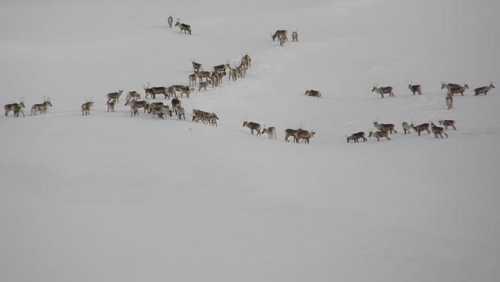
A herd of caribou standing on a hillside of snow. Photo courtesy of US Geological Survey.
How big are calves?
Scientists have weighed quite a few newborn calves in Denali and on average they weigh about 17 pounds.
Calves are born in May and early June throughout Alaska, with most calves being born in any herd within about a 10-day period.
Caribou cows produce one calf each year and generally begin producing calves when they are 2 to 4 years old depending on the nutritional status of a given population.
In small herds, such as the Denali Caribou Herd, calves are subject to intense predation primarily by wolves and grizzly bears – fewer than half survive beyond 2 weeks of age.
In the large, migratory populations, early calf survival is markedly higher because the huge number of calves born over a brief interval can greatly swamp the ability of local predators to kill them.
What do caribou do in the summer?
After the females calve, caribou gather together in large groups to help them better avoid predators and to escape incredibly bothersome mosquitoes and parasitic flies.
The different herds of caribou stay together in the high mountains and along the Alaskan seacoasts where the winds and cooler temperatures help protect them from summer heat and those pesky insects.
After the number of insects decline in late July, the caribou herds scatter into smaller groups.
This is an important time for caribou – they use the time before winter arrives to feed as much as possible on remaining green grasses and sedges, willow leaves, and even mushrooms to regain their body weight.
What do they do in the fall and winter?
In the fall, caribou start migrating – when they migrate is dictated by cues in changing day length in combination with the onset of snowfall as the long winter begins. Fall is also the breeding season when mature bulls compete with each other for opportunities to breed with females as the females become receptive.
In winter, Arctic caribou generally migrate south into the northern fringe of the boreal forest or onto tundra winter ranges where terrestrial lichens are abundant.
Smaller mountain populations migrate out of the higher mountains onto the tundra and forest ranges adjacent to their mountainous summer ranges. Once on their winter range, caribou remain there throughout the winter, from about early October to late April.
What predators eat caribou?
Predation is an important force affecting the number of caribou, particularly in the smaller, more sedentary populations.
The large, migratory herds are able to reduce the effects of predation to some degree just due to their sheer numbers; the tradeoff is that they are more likely to be affected by the nutritional limitations of their ranges compounded by competition with their herd mates.
In general, the primary predators of caribou in Alaska are grizzly bears and wolves. Humans also are important predators of caribou.
Caribou are a mainstay of local subsistence in Bush Alaska, and a sought-after quarry for other Alaskan residents, as well as sport hunters from all over the world. On average, people harvest about 22,000 caribou a year in Alaska.
Grizzly bears are very effective at killing young caribou calves less than a couple weeks old, although they also kill older caribou on occasion.
Wolves are important predators of both young calves and older caribou. Other predators on caribou include black bears, golden eagles, wolverine, and coyotes.
A main goal of Adams’ research has been to understand the interrelationships of caribou and wolves in Denali National Park.
For caribou, an important factor that affects how many are killed by wolves is the amount of snow.
In years with less snow, caribou have large expanses of wind-blown, snow-free land to seek their food, and they have a much better chance of making it through the winter in good shape. They can also more easily evade wolves because they can run unimpeded.
During such times, wolves are able to primarily hunt those caribou that are old, injured, not in good shape or just plain unlucky. Adams has found that when it is harder for wolves to catch caribou, the wolf packs tend to be smaller.
But the wind shifts in favor of wolves when there is a lot of snow.
Caribou then have a harder time finding enough to eat because they have to dig through deep or crusted snow or must seek food on high mountain ridges where there is little snow, but also little food.
The caribou also have a harder time escaping from wolves in deep snow. In fact, wolves will sometimes chase caribou into areas with deep snow where the caribou are very vulnerable, even if they are in good shape.
In those years, wolf packs tend to be bigger and some packs produce more pups. In contrast, research shows that after severe winters, not only is a cow less likely to breed, but calves that are born are lighter, grow more slowly, and are more likely to be killed by predators in the weeks after they are born.
Is climate change affecting caribou?
Scientists know from their studies that weather may be the most important factor affecting the yearly cycles of large hoofed mammals (such as caribou, moose, and muskox) and their predators.
However, the longer-term effects of climate change are much more complex.
Unlike polar bears, which are highly dependent on sea ice that is declining due to warming temperatures, caribou are likely influenced by a wide variety of factors that will be affected by a warming climate, and some effects will be positive and some negative.
For example, with a warming climate, it’s expected that the growing season will be longer and provide caribou with green, nutritious forage earlier for a longer period of time for a positive effect.
However, research indicates that with increasing temperatures there are more fires on boreal forest winter ranges for caribou that will likely result in reduced availability of lichen, their primary winter forage, which tends to not grow back for about 70 to 80 years after a fire.
The overall effect of a warming climate on Alaska’s caribou will be dependent on how these and many other climate-related effects interact and that is very difficult to predict.
Follow Lake County News on Twitter at http://twitter.com/LakeCoNews, on Tumblr at www.lakeconews.tumblr.com, on Google+, on Facebook at www.facebook.com/pages/Lake-County-News/143156775604?ref=mf and on YouTube at www.youtube.com/user/LakeCoNews .

 How to resolve AdBlock issue?
How to resolve AdBlock issue? 